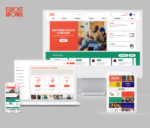
OCTOBER is Cyber Security Awareness Month and an opportunity for all businesses to reflect on the defences surrounding their IT systems.
The Connectus Group specialise in providing solutions in this area for companies of all sizes.
Here in the first of a special three-part series Roy Shelton, the CEO of the Connectus Group explains why mitigating cyber risks is crucial for safeguarding digital assets.
Mr Shelton says: “Cyber risks and threats come in all sorts of shapes, sizes and typically when you least expect them.
“They can originate internally from disgruntled employees or even through the exploitation of hardworking naïve members of staff, to external actors looking mainly for kudos and bragging rights to financial gain.
“These actors spend months typically identifying and exploiting the points of least resistance in your IT systems.
“By reviewing your environment and then developing and deploying a proactive approach to data, cyber and network security regardless of it being people training and awareness , systems access and vulnerabilities you can mitigate cost, complexity and risk for your business.
“Businesses today are under constant threat as cyber attacks and data breaches make headlines and malicious actors continue to adapt and develop new tactics.
“Threats today include targeted hacking and ransomware attacks, email “phishing”, malware, compromised email accounts, fraud, data breaches, social engineering and employee error.
“Political unrest also creates further challenges, and is a reminder of the need for constant awareness of the activities of extremists and terrorist groups that are linked to some hacking and cybercrime groups.
“In terms of specific techniques that could be used to attack a business on the cyber front, social engineering is one of the most dangerous methods used by hackers, as it relies on exploiting human error rather than finding technical vulnerabilities in corporate systems.
It covers a range of malicious activity and involves influencing users through psychological manipulation, creating a sense of urgency, fear, or curiosity where employees feel compelled to perform actions or disclose confidential information.
“It is a key tactic used by hackers and criminals to illicitly obtain business and employee data that can be exploited financially. A report by Verizon in 2021 found that 85% of data breaches involve human interaction.
“Over three quarters of cyber attacks start with an email. So-called “phishing” emails are a type of social engineering tactic involving impersonation, where the goal is to deceive the recipient into clicking on a link that will often trigger the download and installation of malware.
“That could be a fake email purporting to be from a parcel delivery firm with a tracking link, or even a spoofed email from a boss asking for a fake invoice to be paid or funds to be transferred to a bank account.
“One of the common risks here is that a user may download ransomware, which is malware that is designed to deny a user access to their files on their computer or on a network until a payment has been made.
“The software will typically encrypt files and demand a ransom, usually to be paid in a cryptocurrency like Bitcoin, with demands reaching into the millions of pounds for larger firms hit by hackers.
“Affected organisations are often given a deadline before they are threatened with sensitive data being released for free or sold on the Dark Web.
“Third-party exposure is another risk. A recent report from Security Scorecard in the States found that 98% of businesses have a third-party relationship with another business that has experienced a data breach in the last two years.
“The damage can be particularly egregious, as third-party businesses can enjoy privileged access to networks.
“One of the most high-profile examples of a third-party incident is the leaking in 2021 of the details of 214 million users of Facebook, LinkedIn and Instagram via a breach at a contractor called SocialArks, which was blamed on a misconfigured Elasticsearch database.
“The FBI has warned that there has been a 300% increase in cyberattacks since the Covid pandemic and that working from home has made it easier for hackers and criminals to take advantage of people with external access to critical corporate systems.
“It is human factors that are the cause of many cybersecurity threats, which is usually caused by a lack of awareness or training, but with businesses adapting to accommodate remote working, this is an obvious area of risk that needs to be managed.
“Common errors here include poor password security, accidental clicks on malicious links, and failing to follow processes and procedures required when handling sensitive information.
“Mitigating cyber risks is crucial for safeguarding digital assets and minimising the risk of harm from threat actors.
“Regular security assessments and updating all IT software is a must, as is implementing multi-factor authentication (MFA) for email access and remote network logins.
“It is also worth regularly reviewing which employees have administration rights on systems and educating employees on security risks to create a positive culture of security.
“An incident response plan is a great idea so the business can respond rapidly in the event of an attack, as is keeping key information in a separate offline back-up system that can be called upon in emergencies.
“Ensuring physical security at your premises, particularly to server rooms, is also crucial in guarding against a so-called “bare metal” attack where hackers are able to directly access machines.


